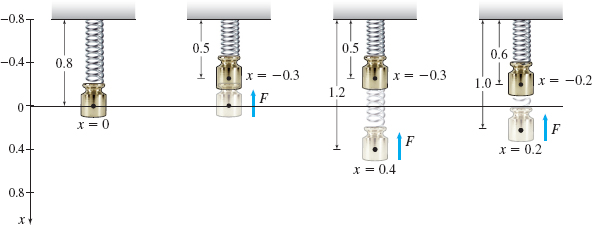EXAMPLE 3Finding the Work Done by a Spring Force
Suppose an 0.8 m-long spring has a spring constant of k=5 N/ m.
- (a) What spring force is required to compress the spring from its equilibrium position to a length of 0.5 m?
- (b) How much work is done by the spring force when compressing the spring from equilibrium to a length of 0.5 m?
- (c) How much work is done by the spring force when compressing the spring from 1.2 to 0.5 m?
- (d) How much work is done by the spring force when compressing the spring from 1 to 0.6 m?
Solution We begin by positioning an axis parallel to the spring and placing the origin at the free end of the spring in equilibrium. See Figure 57.
448
- (a) By Hooke's Law, the spring force is F=−5x. When the spring is compressed to a length of 0.5 m, then x=−0.3 The spring force F required to compress the spring to 0.5 m is F=−kx=−5(−0.3)=1.5 N
- (b) The work W done by the spring force F when compressing the spring from equilibrium (x=0) to x=−0.3 is W=∫−0.30F(x)dx=↑F(x)=−5x∫−0.30(−5x)dx=5∫0−0.3xdx=5[x22]0−0.3=0−5(−0.3)22=−0.225 J
- (c) The work W done by the spring force F when compressing the spring from 1.2 m (x=0.4) to x=−0.3 is W=∫−0.30.4(−5x)dx=5∫0.4−0.3xdx=5[x22]0.4−0.3=52[0.42−(−0.3)2]=0.175 J
- (d) The work W done when compressing the spring from 1 m (x=0.2) to 0.6 m (x=−0.2) is W=∫−0.20.2(−5x)dx=5∫0.2−0.2xdx=5[x22]0.2−0.2=52[0.22−(−0.2)2]=0 J
